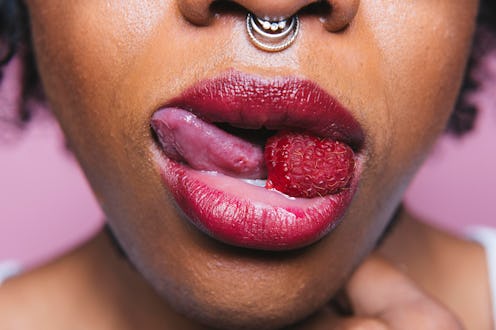Life
8 Fascinating Things You Never Knew About Your Labia

It's possible that you don't think of your labia all that often, except perhaps during your period or when you're getting into very tight jeans. However, the labia minora and majora — the two layers of skin that protect your inner genitalia — are more important for your genital health than you might think. There's also a lot of misinformation about them out there, from urban myths to medical misunderstanding, so it's time to get your labia facts straight.
A refresher on labia anatomy, if you need an update: the outer labia are the labia majora, and the inner are the labia minora. It's the labia minora that makes up the "hood" of the clitoris, but don't let the name fool you: they don't actually have to be smaller than the outer labia, and in many women they aren't. Labia swell with blood when we're aroused and can get irritated by conditions like thrush or allergies; their skin is quite sensitive and easily inflamed (as you'll know if you've ever had an injury or irritation).
You probably don't give your labia a lot of attention, but they do a *lot* for our bodies, and their place in our culture is fascinating. Let's get into the engrossing world of the labia.
1Labias Look All Kinds Of Ways
Contrary to what porn would have you believe, there is not one kind of labia! A study on vulvas published in 2018 revealed that there's actually a huge variety of labia arrangements out there: 657 women were measured for the study, aged between 15 and 84, and the scientists found that labia length, width and symmetry varies a lot. Some factors, like age and weight, seemed to influence labia shapes in certain ways, but the underlying diversity was pretty remarkable.
2And The Labia You Often See In Porn Is Super Rare
It turns out that the kind of labia you see most often in adult films and photography — small, with the labia minora 'tucked' neatly inside the labia majora — aren't actually that common. According to Healthline, it's one of the most uncommon configurations of labia in the world. It's far more common for people to have labial lips that protrude, are uneven or asymmetrical, are curved or prominent, or are so small that they don't offer much protection for your vaginal opening. Everyone's labia is different and great.
3Your Labia Change As You Age
Menopause and age affect the appearance of your labia gradually over time, though the specifics are pretty individual. The labia can become less elastic over time and loosen, while Women's Health points out that estrogen fluctuations due to pregnancy or menopause can also cause darkening of the labia minora in some people.
4That Myth About Red Lipstick Is Just A Myth
There's an old idea that wearing red or pink lipstick is attractive because it reminds the viewer subliminally of engorged, scarlet labia, which indicate arousal. However, a study from the University of Kent in 2012 found that there isn't actually a connection between seeing a certain color and thinking certain kinds of genitals are attractive. The tie is probably nothing more than an urban myth.
5Your Labia Can Change Colors Over The Course Of A Day
When you're aroused, your labia will likely change colors temporarily because it's flooded with blood. In other conditions, though, it can change its color too. Labia tend to darken during puberty and pregnancy as our levels of estrogen fluctuate, so you can expect that your labia may gradually become darker in color over time. Labia can be every color from pink to grey to purplish or brown; there's no one color for them to be.
6Your Labia Can Shows Symptoms Of Autoimmune Conditions
If you have an autoimmune condition, your labia might show evidence. "Compared with other women, a woman who has a systemic autoimmune illness, such as thyroid disease, diabetes mellitus, systemic lupus erythematosus, fibromyalgia, or irritable bowel disease, will have a higher risk of developing an autoimmune vulvar disease," explains medical resource Clinical Advisor. Lichen sclerosus is particularly common among women who have autoimmune conditions; it involves small patches of white skin on the labia and genital skin, though it can involve no symptoms and isn't contagious.
7Labia Can Stick Together
Some very young people can experience a condition known as labial adhesion — aka, the labia grow together. The labia often separate by themselves at puberty, but sometimes it needs treatment with creams or minor surgery. The condition seems to have something to do with low levels of estrogen, because post-menopausal women sometimes experience labial adhesion too.
8Sex Over Time Does Not Affect Your Labia At All
Another urban myth busted: You may have heard that people's labia are larger darker the more sex they've had, but that's fundamentally not true. "There is no evidence that the labia undergoes any permanent changes as a result of having sex," obstetrician Dr. Toli Onon told VICE. The major permanent color-changers for labia are hormonal; temporary color shifts during arousal pass, and don't stick around if you happen to have a lot of sex.
9
Love your labia; those lips do a lot of work to protect your vagina and urethra from harm. Even if they don't have anything to do with your lipstick color.